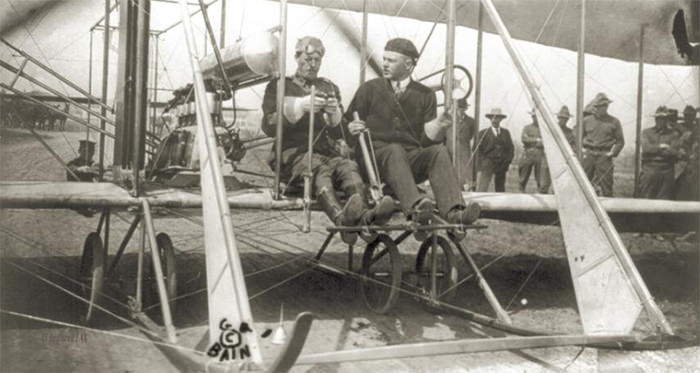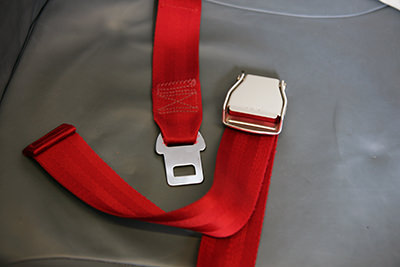“What is the point of a seat belt on a plane?”, I hear you asking. It’s not as if planes would collide above the clouds, and an airplane seat belt would protect you against being catapulted through the window, right? Well, you can’t really compare car and plane safety. Thinking that seatbelts on planes are pointless is just plain wrong. Seat belts and safety are inseparable.
The start of 2024 was marked by three events that highlighted the benefits of airplane seat belts: a plane collision in Tokyo, Alaska Airlines plane losing a door plug, and the Netflix premiere of “Society of the Snow”
People sometimes resist systems that constrict their freedom of movement. Those who see fastening a seat belt as an ultimate punishment, probably on par with wearing an anti-COVID mask, may be missing the reasoning behind this safety procedure. Simply because flights are usually safe, and plane accidents are rare, it doesn’t mean we can diminish the seat belt as an essential safety device.
Personally, I am buckled up in a car even when there’s no police in sight, on a bus even when nobody instructs me to do so, and when flying, even when the plane seat belt sign is not on. I try to prevent negative surprises, and refuse to think about the supposed discomfort seat belt brings.
Especially on long flights, I don’t want to be caught off guard by a sudden shaking of the cabin disturbing my nap. Pro tip: if you plan to sleep on board, always buckle up above the blanket, or you’re risking being awakened by the cabin crew checking if everyone is securely tucked in for a potential (!) event of turbulence.
The year 2024 started with three events that highlighted the undeniable benefits of the use of seat belts. Plane collision in Tokyo, Alaska Airlines‘ mid-flight accident in Portland, and Netflix premiere of “Society of the Snow”, all provided valuable lessons in seat belt safety.
Learn why you should wear a plane seat belt whenever seated!
This article may drop a few spoilers for "Society of the Snow", so keep that in mind if you still plan to see the movie.
Aircraft seat belt history
The first aircraft seat belt was invented in 1911. The US Army General Benjamin D. Foulois came up with a safety strap that would prevent military pilots from being thrown out of the plane.
While his seat belt wasn’t really effective in a plane crash, the aviation world embraced the idea, and aircraft seat belts and harnesses became a standard feature of warplanes.

Post-World War I, civil planes started adopting seat belts too, and in 1926, the USA issued its first seat belt regulations. Two years later, airplane seat belts became mandatory plane equipment, but their use by passengers was still optional.
Those early seat belts were just a protection against basic turbulence. It wasn’t before the late 1940s that seat belt manufacturers started developing enhanced, durable seat belts that could help against injuries too.
However, the public of the 1950s was a tough crowd. Disinformation about seat belts was far more influential than science. Sensationalist reporting from the plane crash sites had folks convinced that airplane seat belts could trap you in a potentially burning seat, or even directly be a cause of death in the event of a crash.
The Federal Aviation Regulations with a mandatory requirement of wearing a plane seat belt during takeoff and landing were codified in 1972. Refusing to fasten a seat belt may cost you a fine of $10,000.
If you are afraid that you would be too big for a plane seat belt, consider purchasing a seat belt extender. Learn more about your options if you think you're too fat to fly.
How airplane seat belt can save your life?
1. Surviving taxiing, takeoff, and landing
The moments of takeoff and landing are considered the most critical phases of every flight. They involve rapid changes in speed and altitude. According to IATA, 53% of accidents in commercial civil aviation between 2005 and 2023 happened during landing.
Securely fastened seat belts ensure that passengers are protected from unexpected events such as a sudden stop or a quick ascent/descent.
There is another seemingly routine flight operation when wearing an airplane seat belt is also mandatory, and that is during the taxiing of the aircraft.
Preparing the plane for departure from a runway, or parking the plane after it landed should not be regarded blithely. These movements may seem minor, but they can still lead to injuries. Even when you hear the plane stopping, always stay securely fastened until the plane seat belt sign has been switched off.
If you need proof of how tricky it can be to navigate at the place where taxiing, takeoff, and landing intertwine, just look at what happened in Tokyo, Japan, on the 2nd of January, 2024. Japan Airlines Flight 516 from Sapporo was landing at Haneda Airport where a coastguard plane was taxiing toward the runway. The collision was fatal for the crew of this smaller plane, while everyone on JAL 516 survived the evacuation from the burning aircraft, with only one passenger ending up with some bruises.
Applying a plane seat belt and following the safety protocols proved crucial in the Tokyo accident not turning into an even greater tragedy.
2. Preventing unexpected skydiving
Once the aircraft is airborne, you typically expect the airplane seat belt sign sound to mark the freedom of movement, ushering an anticipated stampede to the bathrooms. But the potential perils of a flight may not go away by simply leaving the ground.
On January 5th, 2024, Alaska Airlines Flight 1282 experienced a bizarre accident during the ascent. A defective door plug next to seat 26A fell off the plane, opening up a hole that sucked out seat headrests, a seatback cushion, a tray table, two mobile phones, and even a young passenger’s T-shirt from the depressurized cabin.
The pilot of Boeing 737 Max was forced to perform an emergency landing back at Portland Aiport, Oregon, a mere 20 minutes after takeoff.
Meanwhile, in row 25, a mother was holding her now shirtless son from being ejected out of the plane. Luckily, no one was sitting in the two adjoining seats closest to the gaping hole. Miraculously, the door blowout drama left the 177 people on board with no major injuries.
The lesson is obvious: While one of the cell phones was allegedly found undamaged, no passenger would survive such a fall from a 4,900-meter height.
This was a sudden and never-before-experienced accident, and plane seat belts proved to be the first line of defense against passengers being thrown about and out of the cabin. With due respect to mothers.
3. Not getting hurt in a turbulence
Air turbulence is a common occurrence in the skies and can range from mild bumps to more severe jolts. Sudden changes in altitude or unexpected maneuvers may occur throughout the flight, for various reasons. And these won’t always come with a courteous announcement over the intercom.
Weather conditions can change in a matter of seconds, transforming your flight into a roller coaster ride. Clear-air turbulence (CAT) is a type of turbulence that occurs without any visual cues such as clouds, making it challenging for pilots to predict. This unseen threat can jolt the aircraft unexpectedly.
For a visual sneak peek into the unpredictability of turbulence, you need not look further than the first 15 minutes of “Society of the Snow”, Juan Antonio Bayona‘s drama that premiered on Netflix, on January 4th, 2024.
Based on a true story of Air Force Flight 571 in 1972, this survival movie follows a rugby team traveling from Montevideo, Uruguay, to Santiago, Chile.
In the Andes mountain range, unanticipated turbulences start, and a cabin attendant explains the “hungry shark”: “The warm winds from Argentina collide with the cold mountain air, creating a suction effect.” Numa Turcatti, the narrator character, dismisses the theory as a joke.
Only after the second stronger shake, did we hear the captain’s announcement: “Passengers, please fasten your seat belts.”
A third turbulence strike lifts the co-pilot in the air, so that he hits the ceiling of the cabin, exposing the true force a turbulence can make. Sadly, this isn’t an exaggerated movie effect, but an event that could happen on any flight.
When unforeseen turbulence happens, an airplane seat belt acts as a reliable safeguard, minimizing the impact of forces on your body, and preventing you from being lifted off your seat.
That’s why wearing your seat belt at all times, even when the seat belt sign is off, provides continuous protection against the unpredictable nature of air turbulence, and lowers the risk of head injuries and other trauma that can occur during sudden movements.
Despite what "Society of the Snow" may suggest, sitting in the back of the plane has its benefits. The last row is my preferred row in the entire plane!
4. Not dying in a plane crash
When the situation requires an emergency landing or, beyond the pilot’s choices, an impact becomes unavoidable, a plane crash is an unwanted outcome. Not everyone survives the unplanned encounter with a ground.
But as “Society of the Snow” also shows, there’s more we can do to maximize our chances than just gripping armrests for dear life and saying final prayers.
Those who survived the 1972 plane crash in the Andes were those who fastened their seat belts (and had a sprinkle of good luck on the side, of course).
After the plane finally stops gliding through the snow, we see a movie character in an upside-down position, unbuckling their airplane seat belt, and falling out of the seat. Still, this is a much gentler drop than the alternative fate of becoming a human projectile (and “Society of the Snow” shows this too).
The purpose of airport seat belts is to keep you firmly in the seat, preventing you from being tossed around the cabin, and giving you a fighting chance to brace yourself for impact. That could prevent serious injuries, but also make a difference between life and death.
Passengers of Flight 571 employed different strategies to get out of the Andes alive. Learn more about their plane crash survival lessons!
5. Respecting cabin crew authority matters
Before the plane crashes in “Society of the Snow”, one passenger, not understanding the gravity of the situation, pulls a prank, by addressing the cabin via the PA system. “Good afternoon, ladies and gentlemen. This is your Captain, General Carlos Páez“, he says. “Please buckle up so your bodies aren’t scattered across Andes.”
While Páez survived the crash, his joke was prophetic. It got me thinking about the major differences in perception of the cabin crew authority five decades ago and today.
Of course, many things have changed since the time of the tragic Uruguayan flight. We don’t smoke in the planes anymore, we don’t play cards with the flight crew, or casually lounge wherever and however we want. And we don’t ignore the instruction to sit down and buckle up. Well, at least we shouldn’t.

I feel that putting on an airplane seat belt is more than a practical safety measure. It’s a power move establishing the authority of the cabin crew. It’s about following the commands even when we cannot fully understand the context. Blind obedience is a fundamental aspect of air travel safety; it fosters a culture of responsibility and respect for the rules.
The commitment to safety protocols is designed to protect passengers. Choosing not to wear an airplane seat belt disregards the established norms and places everyone at unnecessary risk. As a projectile, you are not just a danger to yourself, but also to other passengers. Also, if you get injured due to your anti-seat belt stance, you could drastically slow down the evacuation or even assistance of the crew.
The cabin crew is trained to handle emergencies for a reason. Their instructions matter. We’ve seen that numerous times, and the successful evacuation at Tokyo airport, just moments before JAL 516 was completely swallowed by flames, shows how important that is.
Tokyo passengers survived the plane crash because they didn't delay the evacuation by retrieving their hand luggage. Read why that is essential for everyone's survival!

Plane seat belt instructions
Fastening and removing a plane seat belt is a straightforward process that the cabin crew explains before every flight. But if you are a first-time flier, you might want to read the exact instructions on how to use seat belts on a plane.
How to put airplane seat belt
- Locate the two parts of the seat belt on each side of your seat, near the hip area. They may be tucked into the seat or hanging from the side.
- Take both ends of the seat belt and insert the metal tongue into the buckle until you hear or feel a click.
- Once the seat belt is fastened, adjust the length to ensure a snug fit. The seat belt should be low across your hips, touching the tops of your thighs, and should not be twisted. Give the belt a gentle tug to make sure it’s securely latched.
- Leave it fastened, even when the seat belt sign is off.
How to unbuckle airplane seat belt
- Locate the seat belt buckle, typically near the hip area on the side of your seat.
- Use your fingers to lift and release the latch on the buckle. The click will indicate successful unbuckling.
- Separate the two ends of the seat belt by pulling them apart.
- Keep seat belt accessible, and neatly stowed within reach. If you’re planning to rest or sleep, you can leave it loosely fastened for convenience in case you need to secure it quickly.

If you have an older child who sits in their own seat, but you're afraid that your kid would not be fully protected by larger seat belts, consider purchasing this portable safety harness, and travel with peace of mind!
Plane seat belt safety – Conclusion
Some passengers may almost be allergic to the airplane seat belt announcement. They don’t find it a coincidence that the plane seat belt light is placed just next to the sign forbidding smoking, another no-discussion policy on board the aircraft. As soon as that unmistakable airplane seat belt tone warns the cabin, these passengers start wiggling, rolling their eyes, and sometimes even just pretending they buckle up.
During turbulence, unexpected events, or emergencies, a plane seat belt is a protector against potential harm and should be prioritized as routine
I’m not sure if people with strong views on airplane seat belts as enemies of freedom of movement can be convinced otherwise.
But the real-life examples, from 1972 to 2024, show that dismissing the importance of strapping in during a flight can lead to avoidable tragic consequences.
Whether facing turbulence, unexpected events, or emergencies, a plane seat belt is a protector against potential harm and should be prioritized as routine, such as stashing personal belongings in the overhead compartment.
By transforming seat belt use into a habit, you’re upping your chances for a longer and healthier life, without starring in a YouTube video or becoming an inspiration for a series of documentary and feature films on flight disasters.
Strapping in should be a non-negotiable habit for every air traveler. It is not only a mandatory, law-required instruction whenever the airplane seat belt light is on. Fastening a seat belt on a plane is a simple act with a significant impact.
Do you keep your plane seat belt on even if the sign is not illuminated?
Let us know in the comments, and pin this article for later!
Disclosure: This post may contain affiliate links, meaning if you click on them and make a purchase, Pipeaway may make a small commission, at no additional cost to you. Thank you for supporting our work! The images in this article have been sourced through Wikimedia, Freepik, and other authors and public domains. In the order of appearance, the credits are as follows: Cartoon characters (cover and pin image) - Ivan Kralj, created with Dall-e Benjamin Foulois - Library of Congress Man buckling up - DCStudio, Freepik Red seat belt - Daniel Schwen, licensed under CC BY-SA 4.0 Seat belt instructions card - Ivan Kralj




